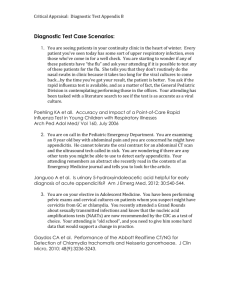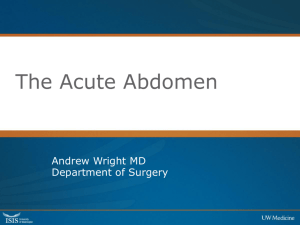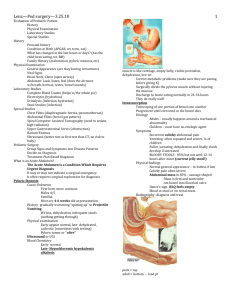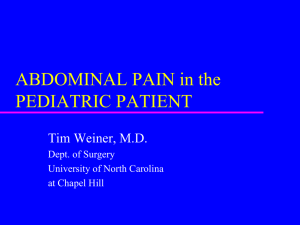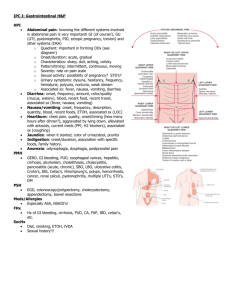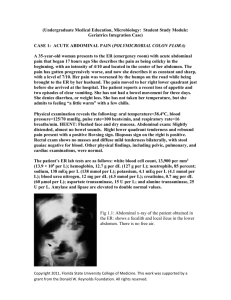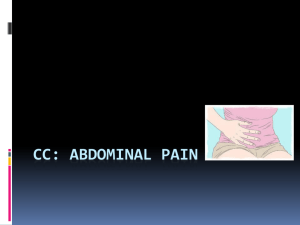Document 14233807
advertisement
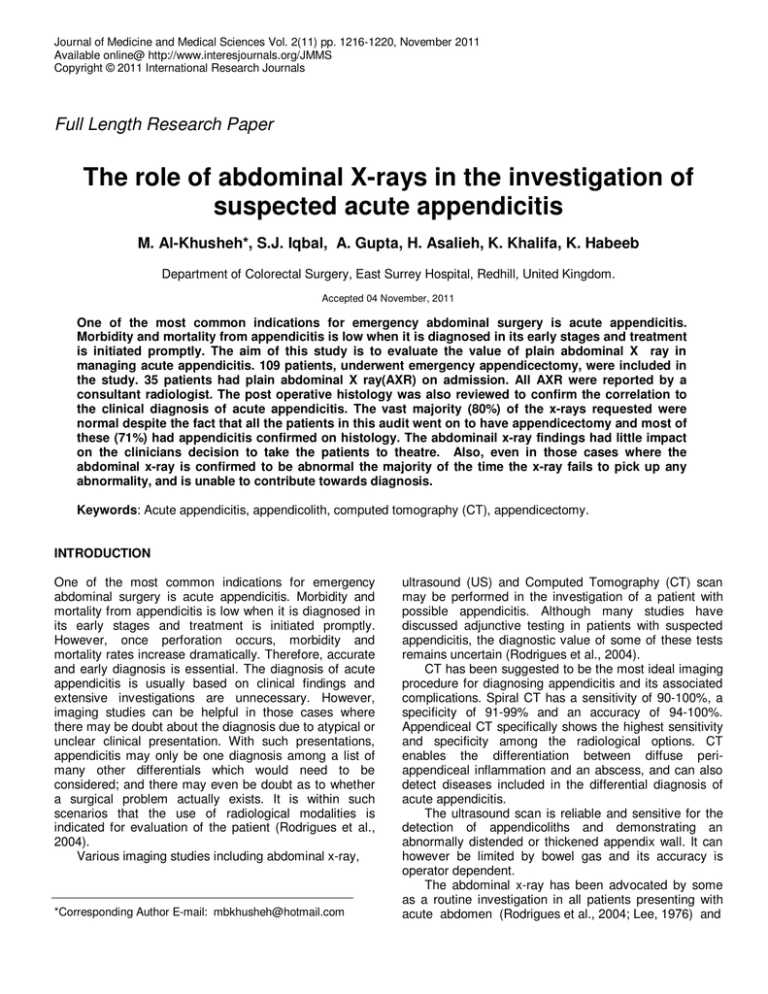
Journal of Medicine and Medical Sciences Vol. 2(11) pp. 1216-1220, November 2011 Available online@ http://www.interesjournals.org/JMMS Copyright © 2011 International Research Journals Full Length Research Paper The role of abdominal X-rays in the investigation of suspected acute appendicitis M. Al-Khusheh*, S.J. Iqbal, A. Gupta, H. Asalieh, K. Khalifa, K. Habeeb Department of Colorectal Surgery, East Surrey Hospital, Redhill, United Kingdom. Accepted 04 November, 2011 One of the most common indications for emergency abdominal surgery is acute appendicitis. Morbidity and mortality from appendicitis is low when it is diagnosed in its early stages and treatment is initiated promptly. The aim of this study is to evaluate the value of plain abdominal X ray in managing acute appendicitis. 109 patients, underwent emergency appendicectomy, were included in the study. 35 patients had plain abdominal X ray(AXR) on admission. All AXR were reported by a consultant radiologist. The post operative histology was also reviewed to confirm the correlation to the clinical diagnosis of acute appendicitis. The vast majority (80%) of the x-rays requested were normal despite the fact that all the patients in this audit went on to have appendicectomy and most of these (71%) had appendicitis confirmed on histology. The abdominail x-ray findings had little impact on the clinicians decision to take the patients to theatre. Also, even in those cases where the abdominal x-ray is confirmed to be abnormal the majority of the time the x-ray fails to pick up any abnormality, and is unable to contribute towards diagnosis. Keywords: Acute appendicitis, appendicolith, computed tomography (CT), appendicectomy. INTRODUCTION One of the most common indications for emergency abdominal surgery is acute appendicitis. Morbidity and mortality from appendicitis is low when it is diagnosed in its early stages and treatment is initiated promptly. However, once perforation occurs, morbidity and mortality rates increase dramatically. Therefore, accurate and early diagnosis is essential. The diagnosis of acute appendicitis is usually based on clinical findings and extensive investigations are unnecessary. However, imaging studies can be helpful in those cases where there may be doubt about the diagnosis due to atypical or unclear clinical presentation. With such presentations, appendicitis may only be one diagnosis among a list of many other differentials which would need to be considered; and there may even be doubt as to whether a surgical problem actually exists. It is within such scenarios that the use of radiological modalities is indicated for evaluation of the patient (Rodrigues et al., 2004). Various imaging studies including abdominal x-ray, *Corresponding Author E-mail: mbkhusheh@hotmail.com ultrasound (US) and Computed Tomography (CT) scan may be performed in the investigation of a patient with possible appendicitis. Although many studies have discussed adjunctive testing in patients with suspected appendicitis, the diagnostic value of some of these tests remains uncertain (Rodrigues et al., 2004). CT has been suggested to be the most ideal imaging procedure for diagnosing appendicitis and its associated complications. Spiral CT has a sensitivity of 90-100%, a specificity of 91-99% and an accuracy of 94-100%. Appendiceal CT specifically shows the highest sensitivity and specificity among the radiological options. CT enables the differentiation between diffuse periappendiceal inflammation and an abscess, and can also detect diseases included in the differential diagnosis of acute appendicitis. The ultrasound scan is reliable and sensitive for the detection of appendicoliths and demonstrating an abnormally distended or thickened appendix wall. It can however be limited by bowel gas and its accuracy is operator dependent. The abdominal x-ray has been advocated by some as a routine investigation in all patients presenting with acute abdomen (Rodrigues et al., 2004; Lee, 1976) and Al-Khusheh et al. 1217 has historically been the first imaging investigation performed on such patients. In acute appendicitis, a plain x-ray abdomen may show (Rodrigues et al., 2004): 1. Fluid levels localized to the caecum and terminal ileum indicating inflammation in the right lower quadrant 2. Localized ileus with gas in the caecum, ascending colon and terminal ileum 3. Increased soft tissue density of the right lower quadrant 4. Blurring of the right flank stripe and presence of a radiolucent line between the fat of the peritoneum and transversus abdominis 5. Faecolith in the right iliac fossa 6. Gas filled appendix 7. Intraperitoneal gas 8. Deformity of the caecal gas shadow occurring due to adjacent inflammatory mass 9. Blurring of the psoas shadow on the right side. The usefulness of abdominal X-rays in acute appendicitis has however been questioned by many, both in its own right and also as compared to other imaging modalities (Figure 1 and 2) (Stower et al., 1985). One study which compared the diagnostic yield of abdominal radiography with that of CT in patients with abdominal pain, found that the diagnostic yield of abdominal radiography was low. This was partly due to the fact that 68% of interpretations were non-specific and therefore could not be diagnostic. The most common non-specific interpretation was that of abnormal bowel gas pattern. The authors suggest that the low diagnostic yield of abdominal x-ray is due to its inherent low softtissue contrast and the fact that many abdominal diseases, including appendicitis, have non-specific radiographic signs. This study in fact found that even for diagnosis for which abdominal x-ray has a high sensitivity, such as bowel obstruction, half of the cases were missed. In the comparison between CT and abdominal X-ray, the study found that CT had a higher sensitivity and similar specificity for multiple diagnoses including bowel obstruction, urolithiasis, appendicitis, pyelonephritis, pancreatitis, and diverticulitis (Ahn et al., 2002). A prospective study of 109 patients with non-classical symptoms of appendicitis using ultrasound and plain abdominal x-rays demonstrated that ultrasound was superior to plain x-ray with a sensitivitiy of 89%, specificity of 96% and overall accuracy of 91% as compared with plain x-ray which had a sensitivity of only 48%, specificity of 93% and overall accuracy of just 67%. This study showed that plain abdominal x-rays are useful in identification of pathology in the RIF though not necessarily accurate in the diagnosis (Makanjuola et al., 1993). Other studies have shown that plain abdominal X-rays are neither sensitive nor specific in the suspected diagnosis of appendicitis. For example, in a review of 821 consecutive patients hospitalized for appendicitis, carried out in the University of Michigan, radiographic findings were noted in 51% with and 47% without appendicitis. No specific x-ray finding was sensitive or specific. The patients were admitted to hospital through an Emergency Department for suspected appendicitis. Of the 821 patients, 642 (78%) received an abdominal X-ray, 524 (64%) had a diagnosis of appendicitis confirmed by pathology. 51% (CI 44.2-54.3%) of patients with appendicitis had findings of some kind on abdominal radiograph. 47% (CI 46.6 to 59.4%) of patients with diagnosis of appendicitis excluded had findings on abdominal radiograph. No individual radiographic finding was statistically more likely to occur in patients with appendicitis compared to those without. Overall radiographic impressions were normal 50 % of the time in patients with appendicitis, and 60 % of the time in patients without (p=0.0075) (Rao et al., 1999). Despite increasing evidence that the routine use of abdominal X-rays in investigating appendicitis is not justified due to its low diagnostic yield, studies continue to show that many patients who present acutely to either emergency departments or surgical assessment units, have an abdominal X-ray as part of their initial work up (Huq et al., 2007). This is also despite the fact that the xray findings have been shown by some studies to have very little impact on management decisions. MJ Stower et al found that after seeing the abdominal film, the diagnosis of the surgical registrar changed in 7 out of 97 patients, and the management plan was changed in only 4 out of 97 patients (Rodrigues et al., 2004). Indiscriminate ordering of x-rays leads to increased healthcare costs and unnecessary exposure to radiation for the patients, and it is therefore important that x-rays are ordered only when necessary and appropriate (Mahawar et al., Available on URL: http://www.edu.rcsed.ac.uk/lectures/lt42.htm). In order to minimize inappropriate requests, The Royal College of Radiologists (RCR) has produced guidelines for ordering plain abdominal radiographs (RCR Working Party, 2003). AXR is indicated: Acute nonspecific abdominal pain (warranting hospital admission and surgical consideration) Acute abdominal pain: suspected perforation or obstruction Inflammatory Bowel Disease: acute exacerbation Chronic pancreatitis AXR is not indicated: Difficulty in swallowing, Suspected oesophageal perforation, Upper GI bleeding, Dyspepsia, Intestinal blood loss, Palpable mass, Constipation, Abdominal sepsis, Jaundice/ Gallstones, Acute pancreatitis (AXR may show calcification in chronic pancreatitis). According to the above guidelines by RCR, routine 1218 J. Med. Med. Sci. Figure1. Acute Appendicitis • Arrowheads point to a soft-tissue mass producing deformity of the caecal air. • I: Ileus Figure 2. Appendicolith • Plain film showing appendicolith. • Arrow points to ileus. • Appendicolith may be seen without clinical signs of appendicitis. imaging is not indicated for suspected appendicitis. Imaging (e.g. US with graded compression) can help in equivocal cases or in differentiation from gynaecological lesions. So too can focused appendix CT (FACT). US recommended in children and young women. results can then be compared with the Royal College of Radiologists guidelines, as well as the general consensus in medical literature with regards to the use if abdominal x-ray in appendicitis, to identify any deviation from what is considered best practice. Suggestions will be made for ways to rectify any deviation. Aim METHODS The aim of this audit was to establish the current practice in our hospital with regards to the investigation of patients with suspected appendicitis with abdominal x-ray. The In order to complete this retrospective audit, the names of consecutive 109 patients who had undergone either open Al-Khusheh et al. 1219 or laparoscopic emergency appendicectomy were retrieved from the theatre log books of the operative theatres at our hospital. The names of these patients were then individually entered into the hospitals PACS computer programme which is used to store all radiographic images taken by the hospitals radiology department. This was done to see if these patients had any plain abdominal x-rays taken. If they had an abdominal x-ray taken, the date on which the abdominal x-ray was taken was checked against the date on which their appendicectomy was done to ensure that the date of the x-ray was within the same admission. It was assumed that if the x-ray was taken within two days of the appendicectomy then it must have been done within the same admission as patients in whom there is a strong suspicion of acute appendicitis are taken to theatre promptly. The dates were also compared to ensure that the x-ray was done before the date of the appendicectomy. For all the patients with abdominal x-rays, the formal reports, which are displayed on the PACS system along with the x-ray images were reviewed. All of the x-rays were reported by Consultant Radiologists. All appendix specimens taken at the time of surgery were sent for histology. The histology results for all patients included in this audit were checked and the histology findings were recorded. The histology for all patients who had a plain abdominal film as part of their admission work up, prior to having their appendicectomy, were then checked to see if the diagnosis of appendicitis was confirmed histologically. If the histology confirmed appendicitis, the x-ray reports were then reviewed to see if they were reported to show any features that suggested a diagnosis of appendicitis. RESULTS A total 109 patients included in the study (52 Female Vs 57 Male). 35 Patients had AXR prior to surgery (32%). 28 patients’ AXR were reported as normal (80%). 7(20%) patients had abnormal AXR. The abnormal findings were as follows: • Coil of dilated small bowel - Small bowel Obstruction • Gas distended loops of small bowel - ?Ileus ?Small bowel obstruction • Distension of the colon • Loops of gas filled small bowel with thickening of bowel wall - ?obstruction • Dilated loops of small bowel with thickened walls - ? obstruction • Faecal loading The post operative histology was also reviewed for these patients. 80/109 patients had appendicitis on his- tology (73%). 19/109 patients had normal appendix on histology (27%). 9/109 patients had other pathology found on histology (8.3%): • • • • • • • • Perforated diverticulum Intraluminal Worm Fibrous obliteration of appendix Endometreosis Epitheliod Granuloma Crohns Disease Carcinoid Tumour Congestion of Appendix Of the 35 patients who had AXR prior to surgery: 6/35 (17%) had normal histology.3 of them (50%) had abnormalities on their AXR. 25/35 (71%) had appendicitis confirmed on histology, of these 25/35 patients with confirmed appendicitis 3/25 (12%) had abnormalities on their AXR. 3/35 (8.6%) had other pathology found on histology (Crohns disease, Carcinoid tumour, Inflammed and perforated diverticulum). All 3 of these patients had normal AXR. 1/35 (2.9%) had unclear histology (?appendicitis ?diverticulum of the appendix). This patient had an abnormal AXR. DISCUSSION Although there is significant evidence to suggest that the routine use of abdominal x-rays to investigate suspected acute appendicitis is not appropriate, this audit of local practice at our hospital has shown that 32% of patients who had emergency appendicectomy received an abdominal x-ray prior to surgery. The vast majority (80%) of the x-rays requested were normal despite the fact that all the patients in this audit went on to have appendicectomy and most of these (71%) had appendicitis confirmed on histology. This not only implies that the x-ray findings had little impact on the clinicians decision to take the patients to theatre, but also that even in those cases where the x-ray is confirmed to be abnormal the majority of the time the x-ray fails to pick up any abnormality, and is unable to contribute towards diagnosis. Of the 20% of patients who had abnormal x-rays, the x-ray findings were very non-specific, and none could be said to give a clear indication that the patient was likely to have appendicitis. In fact, within the formal reports of these abnormal x-rays, none of the consultant radiologists mentioned appendicitis as a possible cause for the abnormalities they were seeing. The most common potential diagnosis given by the radiologists was ‘query obstruction.’ Of the 35 patients who had had an abdominal x-ray, 6 of them (17%) had normal histology, however, 3 of these 6 patients (50%) had abnormalities on their x-rays. It can be said that the fact that for half of patients with normal 1220 J. Med. Med. Sci. histology, x-rays are interpreted as showing an abnormality suggests that there is a poor correlation between abnormal findings on an abdominal x-ray and the diagnosis of appendicitis. Of the 35 patients with abdominal x-rays 25 (71%) of these had appendicitis confirmed on histology, however only 3 of these patients (12%) had an abnormality on their x-ray. It can be suggested that in order for the use of abdominal x-rays to be justified, there should perhaps be a greater percentage of abnormal x-rays in those patients with confirmed appendicitis. CONCLUSION On analysis of the results of this audit, the diagnostic benefit of abdominal x-rays in acute appendicitis needs to be questioned. The results seem to correlate with the results of other studies which have shown that abdominal x-rays have a poor specificity in the diagnosis of appendicitis and have little impact on the decision making of the clinician. Yet it would seem that within the local practice of this hospital, abdominal x-ray is frequently requested when patients with possible acute appendicitis are being investigated. The reason for this is likely to be multi-factorial. It may in part be due to the inexperience of some of the most junior doctors on the acute surgical take team. Although within this particular audit we have not looked at who was making the requests for the x-ray, other studies have shown that the surgical house officers were responsible for the greatest number of inappropriate requests, often making requests whilst expecting the x-ray not to reveal any abnormality (Huq et al., 2007). Another aspect of why so many x-rays were requested may be due to lack of familiarity with Royal College of Radiology guidelines regarding the requesting of abdominal films. If within this trust, these guidelines were made more readily available and junior doctors had specific teaching given to them in this regard, then this is likely to significantly reduce inappropriate x-ray requests. In addition senior review of a patient prior to the requesting of investigations, may also improve rates of inappropriate investigation requests. Greater experience and better clinical acumen will allow more senior surgeons to formulate a clearer and more accurate list of potential differentials based on history and examination of the patients, and this would in itself exclude the need for certain investigation, including abdominal x-rays from being done. REFERENCES Rodrigues G, Kanniayan L, Gopashetty M, Rao S, Shenoy R (2004). Plain X-ray in Actue Appendicits. The internet J. radiol. Vol 3. No:2 Stower MJ, Mikulin T, Hardcastle JD, Amar SS, Kean DM (1985). Evaluation of the plain abdominal X-ray in the acute abdomen. J, the royal society of med. 78: 630-633. Lee PW (1976). The plainh x-ray in the acute abdomen: a surgeon’s evaluation. Br J. Surg. 63 (10): 763-766. Makanjuola D, Al-Qasabi Q, Malabarey T (1993). A comparative ultrasound and plain abdominal x-ray: Evaluation of non-classical clinical cases of appendicitis. Ann Saudi Med. 13(1): 41-46 Rao PM , Rhea JT , Rao JA, Conn AKT (1999). Plain abdominal radiography in clinically suspected appendicitis: diagnostic yield, resource use, and comparison to CT. Am. J. Emergency Med. 17:325-328. Ahn SH, Mayo-Smith WW, Murphy BL, Reinert SE, Cronan JJ (2002). Acute nontraumatic abdominal pain adults patients: abdominal radiography compared with CT evaluation. Radiology. 225 ; 159-164 Huq Z, Keerthi N, Mills A (2007). Assesessment of the utilization of plain abdominal radiography in patients with acute abdominal complaints. The internet J. surg. Vol 10 : No 2 Mahawar KK, Todd A, Datta PK. Date posted: Unknown. Unnecessary plain abdominal films and royal college of radiology guidelines. Date cited: unknown. Available on URL: http://www.edu.rcsed.ac.uk/lectures/lt42.htm RCR Working Party (2003). Making the best use of a department of th clinical radiology. Guidelines for doctors: 5 Edition; London; Royal College of Radiologists
